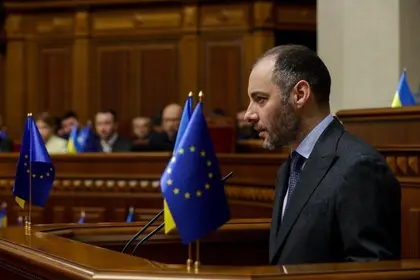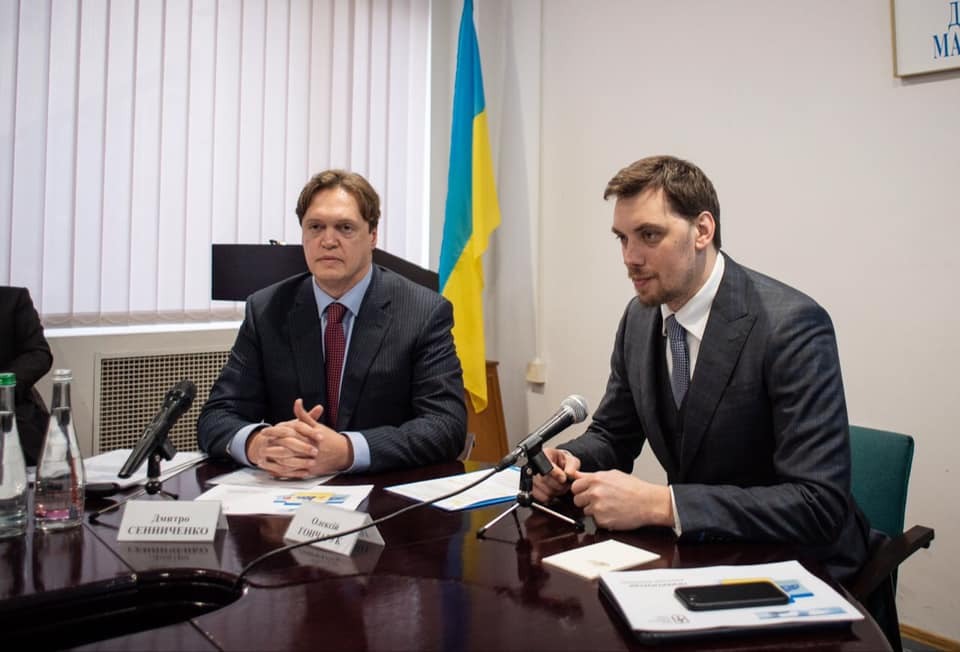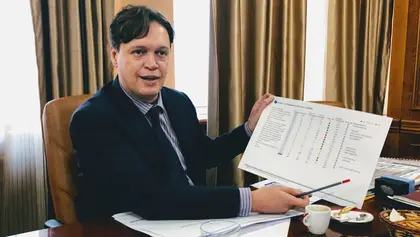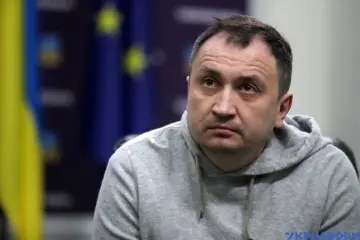The National Anti-Corruption Bureau of Ukraine (NABU) has declared seven people wanted in connection with alleged fraud with the property of Ukraine's State Property Fund. These include ex-Head of the Fund between 2019 and 2022 Dmytro Sennychenko, his advisor Andrii Hmyrin, along with Pavlo Prysiazhniuk, Mykola Parsentiev, Oleksandr Horbunenko, Artur Somov, and Volodymyr Kolot.
At the time of the alleged offences, two were acting directors of the state-owned Odesa Port Plant, one was acting head of the titanium company United Mining and Chemical Company (UMCC), and two were owners of private company Agro Gaz Trading.
As alleged members of a criminal organization, they are accused of embezzling the equivalent of up to $13 million from state-owned companies between 2019 and 2021.
Exposure of the corruption scheme, including wiretapping of alleged participants, was first made by NABU and the Specialized Anti-Corruption Prosecutor's Office (SAPO) on March 22. It was immediately followed by an avalanche of activity by journalists and analysts.
Sennychenko’s case seems to have become one of several investigations by NABU which point to potentially deeply rooted issues of corruption.
How did the alleged corruption scheme work?
Embezzlement of state-owned enterprises has plagued politics and governance of Ukraine since its independence in 1991. Regardless of political intent, successive presidents and governments have resisted privatization moves, presumably as control over state revenues have yielded benefits both personally and for their political groups.

Mystery Surrounds Firing of Deputy Reconstruction Minister
The State Property Fund of Ukraine (SPFU) has been a key factor here, having managed state-owned operations across the country.
The case of UMCC offers a relatively simple example. The company is the prominent manufacturer of ilmenite concentrate in Eastern Europe. Its senior management, appointed by the SPFU, sold its products at below market prices to intermediaries, including unnamed Czech companies, as reported by NABU. In turn, those intermediaries re-sold those products to final buyers at market prices. The margin appears to have been pocketed by beneficiaries of the scheme.
The case of the Odesa Port Plant is more complicated. Built in the 1970s with investment from US businessman Armand Hammer (Occidental Petroleum), the plant grew to become a large manufacturer and exporter of fertilizers such as carbamide and ammonia.
Production depends upon large amounts of gas. Due to the company’s indebtedness, the plant has worked under so-called tolling agreements. A private company supplies the gas, the plant produces fertilizers and hands them over to gas suppliers as a form of payment. The supplier then sells the fertilizers in the open market and pays the plant for their production.
However, prices for fertilizers and gas can be manipulated to generate corruption revenues. In order to secure their flow, it would seem the SPFU appointed “favorable” members of management at the plant and selected a “favorable” gas supplier (“Agro Gas Trading”) during an orchestrated “open competition,” as reported NABU.
Who is Sennychenko?
Sennychenko, 50, has been perceived as a true reformer, with a strong anti-corruption mantra. His impressive career spans roles with the National Bank of Ukraine, Deutsche Gesellschaft für Internationale Zusammenarbeit, U.K. company Parkridge Holdings, and global enterprise Jones Lang LaSalle etc.
In 2019, he was appointed head of the SPFU as a member of Andrii Honcharuk’s reformist government. The move was backed by (then) newly elected President Volodymyr Zelensky.
Sennychenko gained a reputation as an unprecedented “whistleblower” when he publicly reported three cases of bribe offers in exchange for appointments to the management of state-owned enterprises. The bribes totaled almost $6 million.

Dmytro Sennychenko (l.) with former Ukrainian prime minister, Oleksii Honcharuk (r.)
However, NABU believes this to have been a skillful public “cover up” of Sennychenko’s involvement in deals behind closed doors.
After the Russian full-scale invasion, he fled to Western Europe. In October 2022, he was found in Monaco by investigative journalists of Ukrainska Pravda. He did not respond to questions from Ukrainian journalists about NABU’s accusations.
How close could this get to the president?
The latest wanted list could only be the beginning. According to a March 23 Telegram post by Vitalii Shabunin, leader of the Anti-Corruption Action Center, there could be “an interesting extradition story ahead of us” and potential revelations of “names of people from ‘high offices’ who had an equally important role in this scheme.”
Hmyrin could have been one of the “supervisors” or “communicators” between Sennychenko’s group and the Office of the President. Indeed, he has acted as the Office’s “supervisor” over the governmental Economic Security Bureau, according to a March 22 Telegram post by Yaroslav Zheleznyak, first deputy head of the Parliamentary Committee on Finance, Tax and Customs Policy.
“There should be two more people very close to the President’s Office” in the scheme, he added.
Are these people Serhiy Shefir and Tymur Mindych? Shefir founded the Quartal-95 Studio which made Zelensky a commercially successful comedian and actor in the 2000s. In May 2019, he became first assistant to the newly elected President Zelensky. Mindych has been reported as Shefir’s and Kolomoisky’s business partner.
Both men are understood to have been “communicators” between Sennychenko and the President’s Office. This is according to Serhiy Ignatovsky, Sennychencko’s deputy in 2019-2020, in reports of a testimony to NABU detectives. The “protocol of testimony” was published by Ukrainian media Censor.net on April 3.
Neither NABU, Ignatovsky nor Zelensky’s close aides have publicly rejected the authenticity of the testimony or their involvement in Sennychenko’s case.
What were the likely corruption revenues?
Materials of the case unveiled by NABU do not indicate whether alleged corruption revenues were used to finance Zelensky’s “Servant of the People” party or any of his close colleagues.
However, conversations between alleged participants suggest that Sennychenko could have received $200,000 per month. Overall, his revenues could have reached over $1 million from November 2019 to July 2020.
Part of the corruption revenues could also have been spent on a public relations campaign. For example, in April 2021, $25,000 were seemingly spent on spreading posts across social media and among opinion makers etc., as suggested from wiretapping by NABU.
How might certain oligarchs have been involved?
The alleged corruption schemes might have links to the businesses of Ukrainian oligarchs Kolomoisky and Firtash. The person nicknamed as “Grandfather” in NABU’s wiretapping about the Odesa Port Plant was likely to be Kolomoisky, according to the Anti-Corruption Action Center.
Kolomoisky was among the beneficiaries of JSC Ukrnaftoburinnya, as mentioned in the NABU investigation. The company failed to win the competition of gas supplier to Odesa Plant, which went to Sennychenko’s “favorite” Agro Gaz Trading. Surprisingly, Kolomoisky’s company did not go to court over the matter.
Anticorruption activists have assumed the existence of under-the-counter deals between the senior management of the SPFU and the oligarch. For example, Kolomoisky could have “conceded” participation in the Odesa Plant scheme for informal control over state owned JSC Tsentrenergo, one of the largest Ukrainian energy companies, as suggested by an investigation by journalists at Dzerkalo tyzhnia. This could be true since JSC Tsentrenergo was managed by people close to Kolomoisky during the first years of Zelensky’s presidency. Managers were appointed by the SPFU, headed by Sennnychenko.
Meanwhile, Firtash was likely involved in corrupt transactions of the UMCC and investigated by NABU. Two intermediary Czech companies mentioned in NABU materials are the ЕРI Group s.r.o. and Belanto trade s.r.o. as identified by the Crimean Center for Journalist Investigations in December 2022 in reference to a decision of the Appeal Chamber of High Anti-Corruption Court of Ukraine.
Belanto trade bought ilmenite concentrate from UMCC in 2020-21 as uncovered by an earlier investigation by the Center. It is understood to have been further supplied to Firtash’s titanium factory in occupied Crimea by ships under the flags of Syria, Belize and Panama. The factory is the largest manufacturer of dioxide titanium in Eastern Europe. After Russia’s annexation of Crimea, it supplied its products to the Russian market.
What might happen next?
Since its inception, NABU has been under permanent pressure from politicians of all affiliations. The investigation of the Sennychenko case clearly depends upon NABU’s ability to defend its independence.
The government also has its own role to play. It is expected to continue the course of privatization, as emphasized by Transparency International Ukraine in its statement about Sennychenko’s case.
The investigation once again highlights a long-standing problem – where assets are managed by the state there will always be the risk of inefficient management and abuse.
Kyiv Post will be following the Sennychenko case and reporting on further developments.
You can also highlight the text and press Ctrl + Enter






